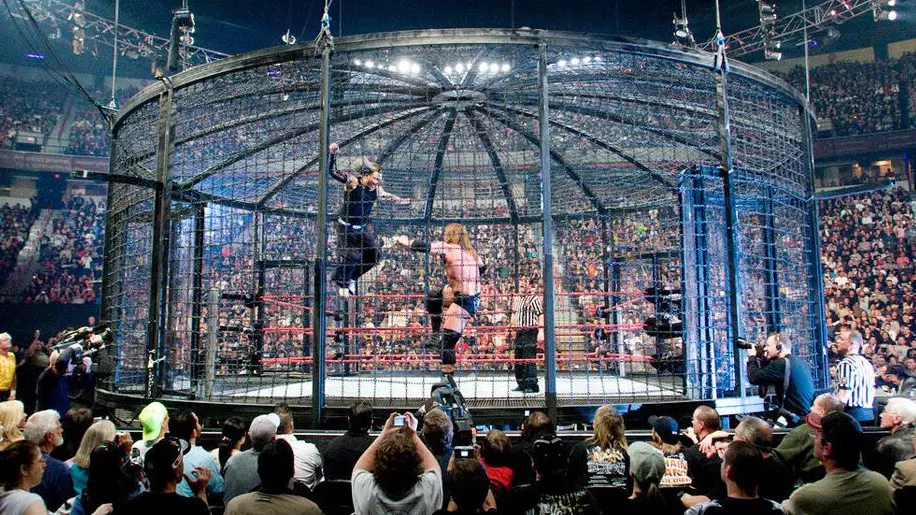
The Elimination Chamber is one of the most dangerous stipulations in professional wrestling.
Before the annual WWE Elimination Chamber pay-per-view (PPV) was introduced in 2010, the match was featured at various other WWE PPV events. Each of these grueling contests has carried a high-stakes stipulation, with the winner either capturing a championship or earning a future title opportunity.
Structure and Design
In the Elimination Chamber, a signature match of the WWE, the ring is surrounded by a massive circular cage made of interlocking chains, closed off by a domed roof. The structure also extends to the ringside area with steel platforms (referred to as "grates"), all at the same height as the ring apron.
The Elimination Chamber structure is made of 16 black-painted steel frames, each weighing 300 pounds (140 kg). The Chamber stands 16 feet (4.9 m) high, has a diameter of 36 feet (11 m), and weighs a total of around 15 tons, of which 10 tons are steel. The chains that make up the cage walls stretch over 2 miles (3.2 km) and weigh 5,400 kg.
Participants and Entrances
The match involves 6 wrestlers. Two competitors start the match in the ring, while the remaining 4 are locked inside small plexiglass chambers called Pods, positioned in the four corners of the cage. Wrestlers from these Pods enter the match at set intervals (typically 5 minutes).
The order of entry is random, announced by a spotlight shining on the Pod of the next competitor to be released. Sometimes, the entry order (or just the final entrant) is determined through prior qualifying matches.
Elimination Rules
This match operates under elimination rules (hence the name). The winner is the last wrestler standing after eliminating all others. Eliminations, including the final one, occur by pinfall or submission anywhere within the structure (since 2012, eliminations must take place inside the ring). Wrestlers can be eliminated even before all participants have entered. Naturally, there is no count-out (due to the enclosed cage), and there is no disqualification (DQ), meaning competitors can use any part of the structure, allow outside interference (though this is rare), and make use of foreign objects (though no weapons are pre-placed inside the chamber).
Origin and Variants
This stipulation was created by Eric Bischoff for the 2002 edition of Survivor Series, a WWE pay-per-view. Since 2010, it has been exclusively featured in the pay-per-view event of the same name.
A variant of this match is the Extreme Elimination Chamber, which has only taken place once (at the December to Dismember 2006 pay-per-view of WWE's ECW roster). The primary difference is that each wrestler inside the side pods has a weapon that enters the match when the wrestler does. In that single occurrence, the weapons used included a table, a steel chair, a crowbar, and a baseball bat wrapped in barbed wire.
Elimination Chamber Match: Info
- Promotion
 World Wrestling Entertainment
World Wrestling Entertainment - Date Established November 17, 2002
- Match Category Cage-Based
- Variant of Tag Team Match Multi-Competitor Match (3-Way / 4-Way / 5-Way / 6-Way) Elimination Match Steel Cage Match
- N. of Competitors 6 - 12
Elimination Chamber Match: Full List of Matches
Below you find the full list of all the Elimination Chamber Matches in history, along with dates and events. You can switch between the match list without spoilers, or view the results with all the winners.
No Spoiler
World Heavyweight Championship 6-Man Elimination Chamber Match
vs.World Heavyweight Championship 6-Man Elimination Chamber Match
vs.World Heavyweight Championship 6-Man Elimination Chamber Match
WWE Championship 6-Man Elimination Chamber Match
ECW World Championship 6-Man Extreme Elimination Chamber Match
vs.6-Man Elimination Chamber Match
vs.6-Man Elimination Chamber Match
vs.World Heavyweight Championship 6-Man Elimination Chamber Matchwo
WWE Championship 6-Man Elimination Chamber Match
World Heavyweight Championship 6-Man Elimination Chamber Match
vs.World Heavyweight Championship 6-Man Elimination Chamber Match
6-Man Elimination Chamber Match
WWE Championship 6-Man Elimination Chamber Match
World Heavyweight Championship 6-Man Elimination Chamber Match
vs.6-Man Elimination Chamber Match
vs.WWE World Heavyweight Championship 6-Man Elimination Chamber Match
WWE Tag Team Championship 6-Tag Team Elimination Chamber Match
vs.The Prime Time Players Darren Young &
Darren Young &  Titus O'Neil [#5]The New Day
Titus O'Neil [#5]The New Day Big E,
Big E,  Kofi Kingston &
Kofi Kingston &  Xavier Woods[#6] C
Xavier Woods[#6] CWWE Intercontinental Championship 6-Man Elimination Chamber Match
WWE Championship 6-Man Elimination Chamber Match
WWE Raw Women's Championship 6-Woman Elimination Chamber Match
7-Man Elimination Chamber Match
vs.WWE Women's Tag Team Championship 6-Tag Team Elimination Chamber Match
The Boss 'n' Hug Connection Sasha Banks &
Sasha Banks &  Bayley[#1]Fire & Desire
Bayley[#1]Fire & Desire Mandy Rose &
Mandy Rose &  Sonya Deville [#2]The Riott Squad
Sonya Deville [#2]The Riott Squad Liv Morgan &
Liv Morgan &  Sarah Logan [#3]vs.
Sarah Logan [#3]vs.WWE Championship 6-Man Elimination Chamber Match
WWE SmackDown Tag Team Championship 6-Tag Team Elimination Chamber Match
The New Day Big E &
Big E &  Kofi Kingston [#2]The Lucha House Party
Kofi Kingston [#2]The Lucha House Party Gran Metalik &
Gran Metalik &  Lince Dorado [#3]vs.
Lince Dorado [#3]vs.6-Woman Elimination Chamber Match
6-Man Elimination Chamber Match
WWE Championship 6-Man Elimination Chamber Match
6-Woman Elimination Chamber Match
WWE Championship 6-Man Elimination Chamber Match
vs.6-Woman Elimination Chamber Match
WWE United States Championship 6-Man Elimination Chamber Match
vs.6-Woman Elimination Chamber Match
vs.6-Man Elimination Chamber Match
#1 Contender (Women's World Championship) 6-Woman Elimination Chamber Match
#1 Contender (Undisputed WWE Championship) 6-Man Elimination Chamber Match
vs.
With Results
World Heavyweight Championship 6-Man Elimination Chamber Match
 Shawn Michaels[#6]def.
Shawn Michaels[#6]def.World Heavyweight Championship 6-Man Elimination Chamber Match
 Triple H[#5]
Triple H[#5]
w/ Ric Flair Cdef.World Heavyweight Championship 6-Man Elimination Chamber Match
WWE Championship 6-Man Elimination Chamber Match
ECW World Championship 6-Man Extreme Elimination Chamber Match
 Bobby Lashley[#5 - table]def.
Bobby Lashley[#5 - table]def. Rob Van Dam[#1]
Rob Van Dam[#1] Hardcore Holly[#2]
Hardcore Holly[#2] CM Punk[#3 - chair]
CM Punk[#3 - chair] Test[#4 - crowbar]
Test[#4 - crowbar] Big Show[#6 - barbed wire bat] C
Big Show[#6 - barbed wire bat] C6-Man Elimination Chamber Match
 The Undertaker[#1]def.
The Undertaker[#1]def.6-Man Elimination Chamber Match
 Triple H[#5]def.
Triple H[#5]def.World Heavyweight Championship 6-Man Elimination Chamber Matchwo
WWE Championship 6-Man Elimination Chamber Match
World Heavyweight Championship 6-Man Elimination Chamber Match
 Chris Jericho[#4]def.
Chris Jericho[#4]def. R-Truth[#1]
R-Truth[#1] CM Punk[#2]
CM Punk[#2]
w/ S.E.S. (Luke Gallows & Serena) Rey Mysterio[#3]
Rey Mysterio[#3] John Morrison[#5]
John Morrison[#5] The Undertaker[#6] C
The Undertaker[#6] CWorld Heavyweight Championship 6-Man Elimination Chamber Match
6-Man Elimination Chamber Match
WWE Championship 6-Man Elimination Chamber Match
World Heavyweight Championship 6-Man Elimination Chamber Match
 Daniel Bryan[#6] Cdef.
Daniel Bryan[#6] Cdef.6-Man Elimination Chamber Match
 Jack Swagger[#3]
Jack Swagger[#3]
w/ Zeb Colterdef.WWE World Heavyweight Championship 6-Man Elimination Chamber Match
WWE Tag Team Championship 6-Tag Team Elimination Chamber Match
The New Day ( Big E,
Big E,  Kofi Kingston &
Kofi Kingston &  Xavier Woods[#6]) Cdef.Cesaro & Tyson Kidd [#3]The Prime Time Players (Darren Young & Titus O'Neil [#5])
Xavier Woods[#6]) Cdef.Cesaro & Tyson Kidd [#3]The Prime Time Players (Darren Young & Titus O'Neil [#5])WWE Intercontinental Championship 6-Man Elimination Chamber Match
WWE Championship 6-Man Elimination Chamber Match
WWE Raw Women's Championship 6-Woman Elimination Chamber Match
7-Man Elimination Chamber Match
 Roman Reigns[#5]def.
Roman Reigns[#5]def.WWE Women's Tag Team Championship 6-Tag Team Elimination Chamber Match
The Boss 'n' Hug Connection ( Sasha Banks &
Sasha Banks &  Bayley[#1])def.Fire & Desire (Mandy Rose & Sonya Deville [#2])The Riott Squad (Liv Morgan & Sarah Logan [#3])The IIconics (Billie Kay & Peyton Royce [#4])
Bayley[#1])def.Fire & Desire (Mandy Rose & Sonya Deville [#2])The Riott Squad (Liv Morgan & Sarah Logan [#3])The IIconics (Billie Kay & Peyton Royce [#4])WWE Championship 6-Man Elimination Chamber Match
WWE SmackDown Tag Team Championship 6-Tag Team Elimination Chamber Match
 The Miz &
The Miz &  John Morrison[#4] Cdef.The New Day (Big E & Kofi Kingston [#2])The Lucha House Party (Gran Metalik & Lince Dorado [#3])Dolph Ziggler & Robert Roode [#6]
John Morrison[#4] Cdef.The New Day (Big E & Kofi Kingston [#2])The Lucha House Party (Gran Metalik & Lince Dorado [#3])Dolph Ziggler & Robert Roode [#6]6-Woman Elimination Chamber Match
6-Man Elimination Chamber Match
WWE Championship 6-Man Elimination Chamber Match
6-Woman Elimination Chamber Match
WWE Championship 6-Man Elimination Chamber Match
 Brock Lesnar[#5]def.
Brock Lesnar[#5]def.6-Woman Elimination Chamber Match
WWE United States Championship 6-Man Elimination Chamber Match
 Austin Theory[#3] Cdef.
Austin Theory[#3] Cdef.6-Woman Elimination Chamber Match
 Becky Lynch[#1]def.
Becky Lynch[#1]def.6-Man Elimination Chamber Match
#1 Contender (Women's World Championship) 6-Woman Elimination Chamber Match
#1 Contender (Undisputed WWE Championship) 6-Man Elimination Chamber Match
 John Cena[#5]def.
John Cena[#5]def.
Elimination Chamber Match: Wrestlers With Most Wins
| Rank | Wrestler | Wins |
|---|---|---|
| Triple H | 4 | |
| John Cena | 4 | |
| Daniel Bryan / Bryan Danielson | 3 | |
| Edge / Adam Copeland | 2 | |
| Drew McIntyre | 2 | |
| 6 | Bianca Belair | 2 |
Who won the most Elimination Chamber Matches?
The wrestler that won the most Elimination Chamber Matches is Triple H and John Cena with four victories, followed by Daniel Bryan with three, and Edge, Drew McIntyre and Bianca Belair with two.
Elimination Chamber Match: Wrestlers With Most Appearances
| Rank | Wrestler | Appearances |
|---|---|---|
| Randy Orton | 9 | |
| Chris Jericho | 8 | |
| John Cena | 8 | |
| Triple H | 6 | |
| Kofi Kingston | 6 | |
| 6 | Liv Morgan | 6 |
Who competed in the most Elimination Chamber Matches?
The wrestler that competed in the most Elimination Chamber Matches is Randy Orton with nine appearances, followed by Chris Jericho and John Cena with eight, and Triple H, Kofi Kingston and Liv Morgan with six.















































































































































































